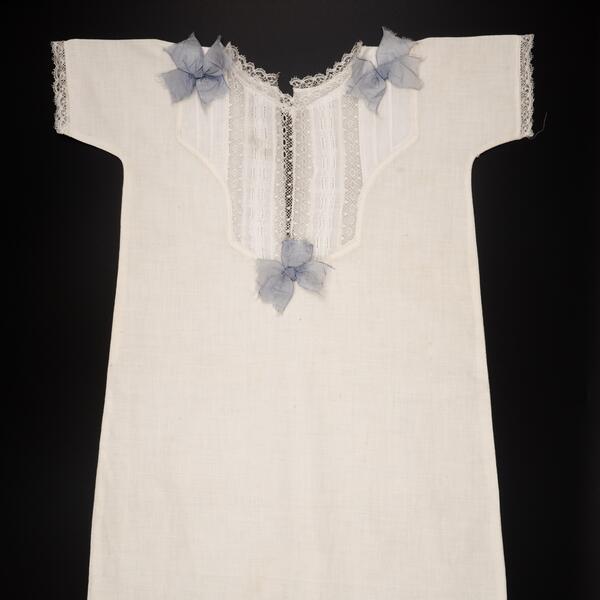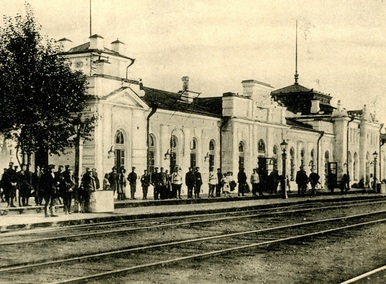Baptism is one of the most important Christian sacraments. Through baptism, a person becomes a member of the Church and gets the opportunity to participate in other Christian sacraments. The baptism ceremony exists in various Christian denominations, although it has its differences. In the Orthodox Church, baptism is executed by triple immersion in a baptismal font with holy water.
Baptism has long been an important stage in a person’s life. Before the revolution of 1917, the nobles, merchants, lower middle class, and peasants, that is, all layers of Russian society who belonged to the Orthodox faith baptized their children. The child was christened, as a rule, in the second week after birth. By the day of the ceremony, it was necessary to prepare a cross, a white christening shirt, and a towel. According to the custom, everything necessary for baptism was purchased by the godparents of the child.
The exhibition presents a christening shirt for boys. Its white color symbolized the purity and innocence of the soul that a person received from God. The shirt is decorated with blue bows. For girls, shirts were decorated with pink bows, and decoration with discreet embroidery or lace was also allowed.
The child was dressed in baptismal clothing at the last moment of the sacrament, after bathing in a font with holy water. The clean, white baptismal clothing symbolized the purification from the original sin and the renewal of life. Such clothes most often were cotton, the cut was extremely simple. Shirts for baptism — both men’s and women’s — had a straight cut with widening at the bottom. Bright colors were categorically prohibited: this was especially true of the red color, which was a symbol of person’s maturity in Rus.
There was also a difference in the length of the clothes for baptism. For male babies, they were supposed to be just below the knees. The christening shirt for girls was a little longer and was often with a yoke. These traditional garments in Rus were as similar as possible to the ones in which the ancient Christian babies had been baptized.
The shirt was supposed to be loose, with sleeves no higher than the elbow. It could have the form of a short baby’s undershirt with soft ties on the back or be pulled over the head. If instead of ties, fasteners or buttons were used, then the shirt was sewn with an undercloth so as not to injure the baby’s skin. Having dressed the baby only once in the baptismal clothes, the shirt was then kept for many years as a sacred object in memory of the day of the baptism.
Baptism has long been an important stage in a person’s life. Before the revolution of 1917, the nobles, merchants, lower middle class, and peasants, that is, all layers of Russian society who belonged to the Orthodox faith baptized their children. The child was christened, as a rule, in the second week after birth. By the day of the ceremony, it was necessary to prepare a cross, a white christening shirt, and a towel. According to the custom, everything necessary for baptism was purchased by the godparents of the child.
The exhibition presents a christening shirt for boys. Its white color symbolized the purity and innocence of the soul that a person received from God. The shirt is decorated with blue bows. For girls, shirts were decorated with pink bows, and decoration with discreet embroidery or lace was also allowed.
The child was dressed in baptismal clothing at the last moment of the sacrament, after bathing in a font with holy water. The clean, white baptismal clothing symbolized the purification from the original sin and the renewal of life. Such clothes most often were cotton, the cut was extremely simple. Shirts for baptism — both men’s and women’s — had a straight cut with widening at the bottom. Bright colors were categorically prohibited: this was especially true of the red color, which was a symbol of person’s maturity in Rus.
There was also a difference in the length of the clothes for baptism. For male babies, they were supposed to be just below the knees. The christening shirt for girls was a little longer and was often with a yoke. These traditional garments in Rus were as similar as possible to the ones in which the ancient Christian babies had been baptized.
The shirt was supposed to be loose, with sleeves no higher than the elbow. It could have the form of a short baby’s undershirt with soft ties on the back or be pulled over the head. If instead of ties, fasteners or buttons were used, then the shirt was sewn with an undercloth so as not to injure the baby’s skin. Having dressed the baby only once in the baptismal clothes, the shirt was then kept for many years as a sacred object in memory of the day of the baptism.



